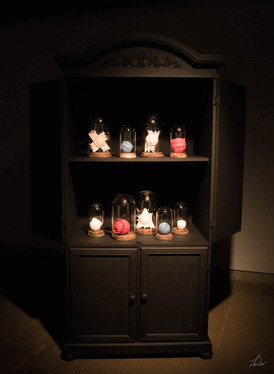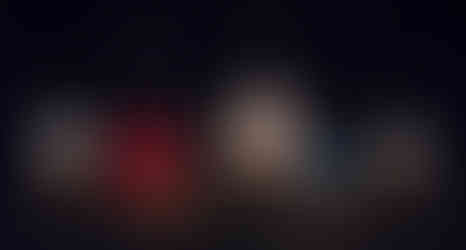Celestial Wonders – an astronomical collaboration between Science and Art
- Nicole Avakyan
- Oct 1, 2018
- 6 min read
By Sean Zhang
I had the opportunity to visit the opening night event for Merveilles célestes - Celestial Wonders, an astronomy-inspired art exhibition presented by Bettina Forget and Yann Pocreau at Université de Montréal’s Centre d’exposition. The exhibition is the culmination of over three months of intricate work by the two artists in the artist-in-residence program at Mont-Mégantic Observatory, an astronomical research facility which houses the second largest telescope in Eastern Canada.

The exhibition is held in an expansive softly lit room, where gentle lights shine onto the individual displays. A calming darkness envelops the entire hall like a cloth woven from the night sky, and the works themselves twinkle like stars. Here, I had the opportunity to speak to Bettina Forget, Fine Arts Director at Convergence, PhD candidate in Art Education and owner of the Visual Voice Gallery in Montreal, about her artwork and experience working at the Mont-Mégantic Observatory.
The Observatory is located at some distance from urban areas, over 2 hours away from Montreal, and sits upon one of the tallest peaks in Eastern Canada, at an altitude of 1100 metres where snow sat frozen on the ground even in June (remember how hot it was in Montreal this summer?). The isolation is necessary, as light pollution from large cities such as Montreal makes it difficult to observe the heavens in detail. In fact, the area surrounding Mont Mégantic is part of a special effort to reduce light pollution around the observatory – it represents a dark-sky reserve (the first of its kind). Yet still, Bettina informed me that during her stay at the Observatory, there was only around 25% chance of having a clear night sky offering a glimpse at the stars due to weather conditions. However, there was always work to be done in maintaining the large and expensive instruments housed at the facility. Bettina reminisced fondly even of the rainy days, recalling that the team would stay inside and enjoy board games in the cozy 4000 sq. ft. space.
We continued conversing as we visited some of the exhibits on display.

I was first introduced to a cabinet housing an intriguing collection of what appeared to be planets within jars. The models had fantastical features – some had jagged edges, others, spikey rings. Bettina affectionately called it her ‘cabinet of curiosities’. During her residency, Bettina worked with astronomers on exoplanet discovery – that is, the discovery of planets outside of our solar system. Using real exoplanet data, such as planet mass, orbit inclination, and star mass, collected by the astronomers at the observatory, Bettina then input these numbers into an STL file – a ubiquitous type of file used in printing 3D models (just as JPEG is a common file type for images). After playing around with the numbers, she was able to print some of these 3D models.
“I basically glitched the data of the exoplanet files. I had to curate them to close some planes in order to make them in 3D space. Most people want the 3D models to print nicely - but I’m an artist and I like to break things!”
The Cabinet of Curiosities. Credit: Lily Jiménez-Dabdoub
Bettina remarked that there is no standard taxonomy to classify exoplanets (many are merely categorized with reference to the eight planets of our own solar system, such as ‘super-Earth’ or ‘Jupiter-like’, although not all exoplanets fit into such categories), and that the aim of this work was a creative rendition to showcase the usage of data on certain exoplanet features to classify planetary models. Aside from the models shown in the cabinet, there were other abstract diagrams displayed in a separate case – these figures would have been impossible to render in 3D, and so I could only appreciate these enigmatic illustrations in their 2D form, printed on paper.

We next arrived at a series of illuminated panels depicting four cosmologists, their history, and their work. I immediately noticed two common themes: their research was about galactic revolutions, and all the researchers presented were female. During the rainy days, Bettina said that she sometimes visited the ASTROLab, which houses a museum about astronomy. Within the museum was a room dedicated solely to cosmology.
“I was reading through, and I said ‘wait a minute, there are no women at all in this exhibit!’ I hadn’t planned on doing these [panels], as I was planning only on doing the exoplanets.”
Bettina decided to take on this additional project about impactful women cosmologists, carefully creating her own panels so that they remained faithful to the museum’s display in theme, layout, and colors. The women featured were: Beatrice Tinsley, Vera Rubin, Sandra Faber, and Margaret Geller. Bettina hopes that young women who are interested in the study of space will not be dissuaded because they perceive that the discipline is solely for men.
“In a museum space there is lots of educational activity for young girls. And there are photos of men looking at them in all directions and they get the impression that cosmology is not for them. And the boys too could think that the girls suck at math, but studies have shown that that’s just not true. Part of my PhD research is actually all about young girls and science.”


Bettina has offered to donate these panels to the ASTROLab after the Merveilles célestes exhibit ends.
I inquired further about Bettina’s own inspiration for creating art, and more particularly art inspired by astronomy. She told me that since childhood, she had always been curious about space, yet that fascination was often quelled by her family’s insistence that she pursue art, as she came from a family of artists. While she followed her family’s advice in studying art, the flame burning for astronomy was never truly extinguished, and was definitively rekindled when Bettina was in her twenties. After viewing a beautiful meteor shower in rural Singapore, Bettina felt driven to purchase a telescope as a birthday gift for herself that year. As fateful as wishing upon a shooting star, the meteor shower became the catalyst for Bettina’s enduring interest in astronomy down the road, prompting her to then join the Astronomical Society of Singapore, and the Royal Astronomical Society of Canada when she later moved to Montreal.
While her works showcase her accomplishment as an artist, Bettina is also clearly knowledgeable about the scientific aspect to her projects. Noticing this, I asked her whether she believed that scientists should maintain an interest in art, and vice versa. She remarked: “I think it’s [art and science] pretty much the same thing. At the research level, we’re doing the same kind of work. For me to do this residency, I needed to learn about exoplanets. I’m not interested in simply making pretty, aesthetic pictures; that’s not what art is to me. Art for me is to be formulating a research question, exploring it, getting information, questioning it, critiquing it. And for that you need to understand what science does. There is a scientific method. Artists have methods, too – they are inquisitive and rigorous in their process as well – I think there is a lot of overlap.”
After hearing all of Bettina’s diverse exposure to both the arts and the sciences, I couldn’t help but ask her whether she had ever considered a career as a scientist rather than as an artist. Her eyes immediately filled with excitement (and perhaps a thread of indignation). “If only somebody had given me a telescope when I was 12 instead of a stupid dollhouse I never played with! But as an educator now, I want to break the divide,” she shared.

As for Bettina’s future plans? She is already imagining a plethora of endeavors to fill over five years of work. Additionally, she hopes to keep exploring the field of exoplanets, but also astrobiology – and whether life exists on other planets. In her PhD, Bettina would like to see that her research in STEAM education (think STEM – Science, Technology, Engineering, Math but with the addition of A for Art) will motivate more girls to pursue science. Bettina hopes for more collaborations between the disciplines of science and art, and encourages both artists and scientists to cooperate on projects.
“We limit ourselves thinking ‘oh, I can’t do math’, ‘oh, I can’t draw’ – doesn’t matter! Just take photos, or do an interpretive dance! It’s important to venture into each others’ space and find common points.”
You can see the rest of Bettina and Yann’s work in Merveilles célestes at the Centre d’exposition de l’Université de Montréal (2940 chemin de la Côte-Sainte-Catherine – near the Université-de-Montreal metro), which will be on display until December 15, 2018.
More of Bettina Forget’s artwork can be found at www.bettinaforget.com
Editing: Nicole Avakyan












Comments